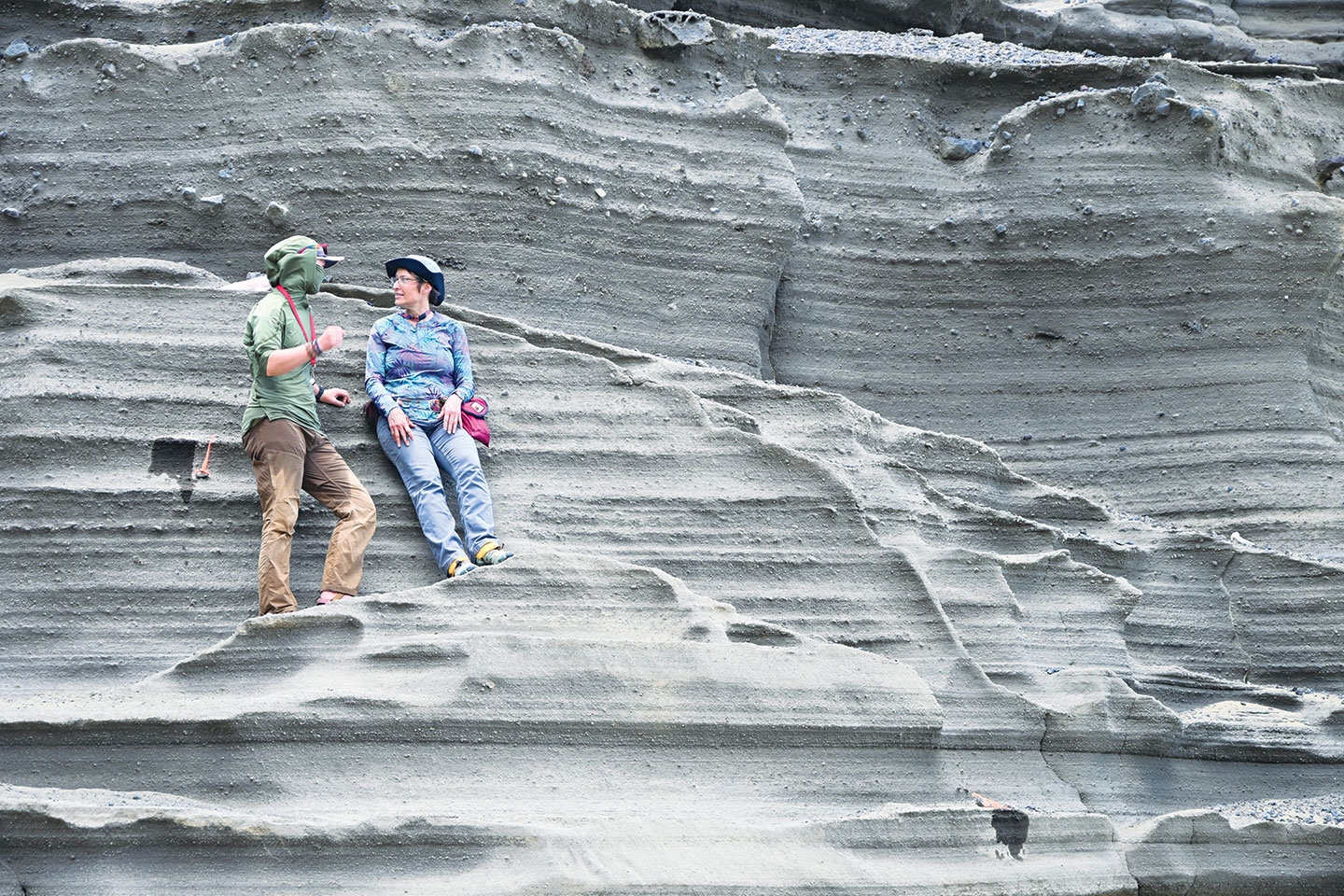

Professor Nicolaysen Inspires Next-Gen Volcano Researchers
Professor of Geology Kirsten Nicolaysen and her students travel the world finding fascination and inspiration in volcanoes
By Debbie Ritenour
Growing up on a sheep and cattle ranch in central Wyoming, Whitman College Professor of Geology Kirsten Nicolaysen spent all her time outdoors. She developed an early interest in geology, but her passion for volcanoes didn’t erupt until she studied the lava flows of Mount McLoughlin in Oregon as an undergraduate at Colorado College.
“I never looked back from that,” says Nicolaysen, who later earned her Master of Science degree from the University of Wyoming and her doctorate from the Massachusetts Institute of Technology. “Although I promised my parents that I would never work on active volcanoes, I’ve broken that promise repeatedly because of my fascination with them.”
Throughout her career, Nicolaysen has participated in research expeditions to everywhere from the Aleutian Arc in Alaska to the Kerguelen Islands in the southern Indian Ocean. These experiences helped her develop a deeper understanding of volcanoes, their roles in generating resources and hazards for people and ecosystems, and the joys of scientific collaboration. Today, she shares that understanding with the Whitman students she mentors through student-centered research projects.
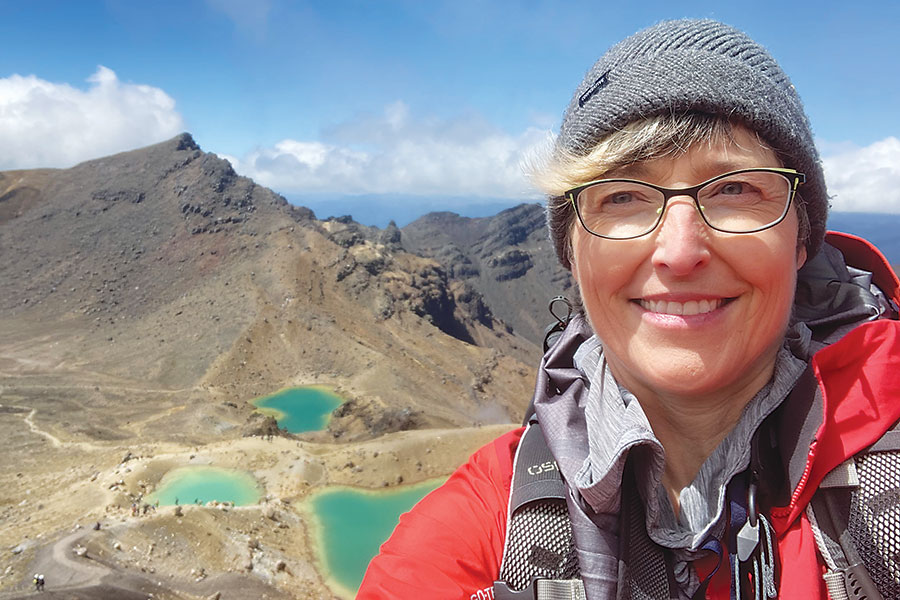
A model mentor. Professor of Geology Kirsten Nicolaysen at Mount Tongariro in New Zealand.
“It’s so inspiring to watch a student blossom through the process of gaining skills and developing their identities as scientists,” Nicolaysen says. “We get to hear about their histories and dreams, and we get to watch them excel. When they complete their senior thesis, it leads to tremendous confidence and agency.”
Through her example and mentorship, Nicolaysen has inspired a new generation of geoscientists to focus their scientific research and careers on the inner workings and outer impacts of volcanoes.
Read on to explore some of the unique journeys by Nicolaysen’s students-turned-volcanologists.
Investigating the How & the Why
Jessie Bersson ’18 began studying magma storage conditions during a summer research project funded by the Keck Geology Consortium, a collaboration of 13 liberal arts colleges that creates transformative research opportunities for undergraduates. As a rising senior at Whitman, Bersson conducted fieldwork at the Wotten Waven Caldera on the Caribbean island of Dominica.
“Some of the main questions I was investigating were what causes a volcano to change from being very explosive to being more effusive and what conditions within the magma reservoir control that change,” says Bersson, who worked with Nicolaysen to expand on her research for her honors thesis. “That has really important implications because you want to know when a volcano might erupt very explosively and produce dangerous hazards.”
“It’s so inspiring to watch a student blossom through the process of gaining skills and developing their identities as scientists.
”
Kirsten Nicolaysen
After graduating from Whitman, Bersson completed an internship with the Cascades Volcano Observatory before earning her doctorate in Geological Sciences from Arizona State University. Her graduate research focused on preeruptive magmatic processes at Mount St. Helens and Glacier Peak in the Cascades and silicic lava flow secondary explosions in the Valles Caldera in New Mexico. She currently is completing a two-year postdoctoral fellowship at the Smithsonian Institution’s Department of Mineral Sciences.
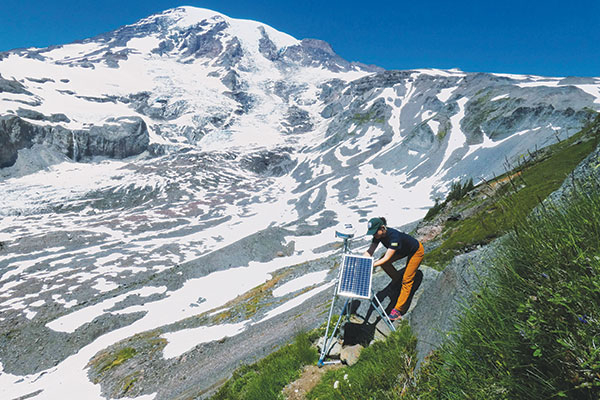
Measuring movement. Jessie Bersson ’18 installs a time-lapse camera at Mount Rainier’s Nisqually Glacier to capture changes to glacial mass balance related to climate change.
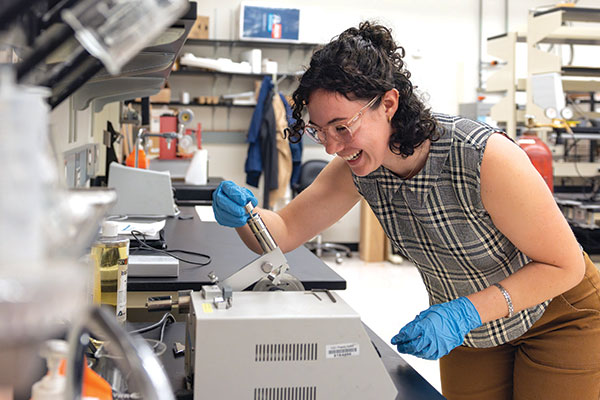
From the field to the lab. As a member of the Experimental Petrology and Igneous processes Center (EPIC) lab at Arizona State University, Jessie Bersson ’18 investigates magma formation.
“I think about volcanic hazards in the fundamental sense of what causes magma to move from the crust to the surface or what causes eruptions to initiate in the first place,” Bersson says. “There are still a lot of processes we don’t understand.”
Observing the Aftermath
If Bersson thinks about the causes of volcanic eruptions, Gustavo Béjar López ’20 thinks about their effects. A doctoral student in the Geology program at Michigan Tech University, Béjar López focuses on detecting and characterizing lahars— the devastating volcanic mudflows that can follow an eruption.
“Lahars can be really dangerous, even in the Seattle area, where Mount Rainier has the potential to create large lahars,” Béjar López says. “Forty years ago, lahars completely destroyed a city of 25,000 people in Colombia.”
Béjar López met Nicolaysen as a student at Yachay Tech University in his native Ecuador. Nicolaysen was teaching a volcanology course as a visiting professor during a sabbatical in 2016, and she suggested Béjar López consider transferring to Whitman. He did—and later received a Whitman Internship Grant that allowed him to work at the Colima Volcano Observatory in Mexico. While there, he collected lava samples at Volcán Ceboruco that he later studied for his honors thesis.
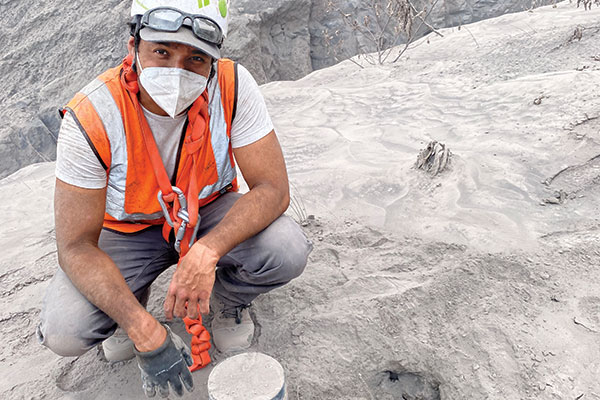
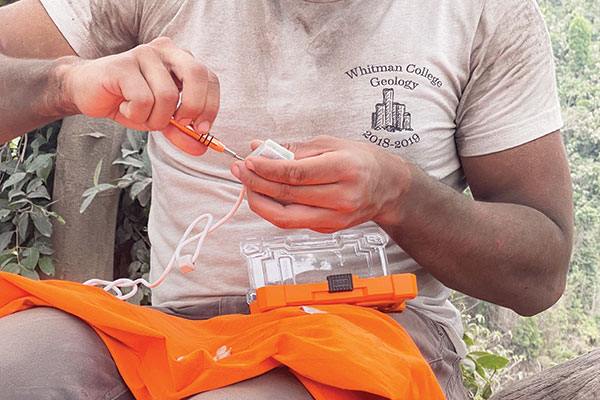
Answers in the ashes. Gustavo Béjar López ’20 services a sensor and monitors a rain gauge buried in ash after a 2022 eruption of Volcán de Fuego in Guatemala, where he studies lahars, dangerous mudflows that can follow a volcanic eruption.
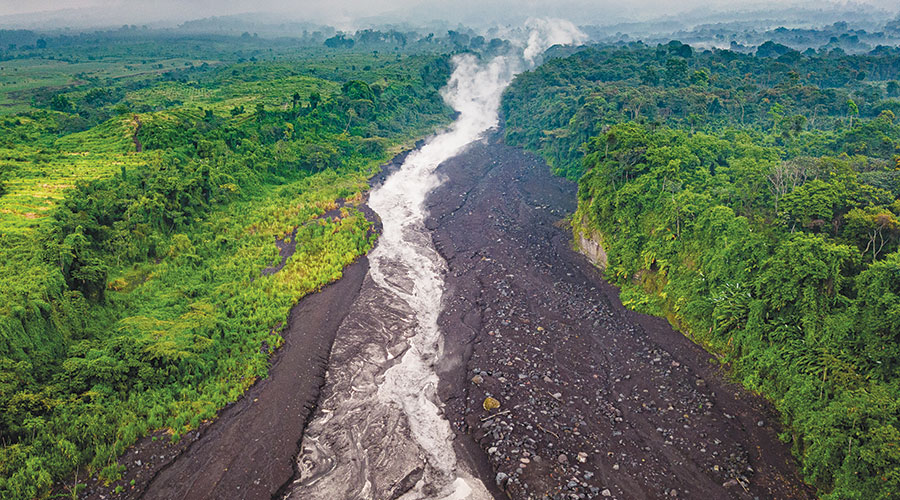
Danger zone. A lahar (volcanic mudflow) captured via drone by Gustavo Béjar López ’20 on May 28, 2023, on the Barranca Ceniza ravine near Volcán de Fuego in Guatemala.
As a National Geographic Explorer grantee, Béjar López is studying lahars at Volcán de Fuego in Guatemala. Through geophysical detection methods and rainfall analysis, he hopes to better understand the generation and flow behavior of lahars. Ultimately, his work could help scientists develop automated methods to predict and detect lahars.
“A lot of people live around volcanoes because they provide fertile soils and have significant cultural and tourism benefits,” says Béjar López. “We can’t just tell them to leave and go somewhere else. We have to provide the tools to help them be safe around them.”
Opening New Waves of Climate Research
Other Whitman alumni are focusing on the role volcanoes can play in shaping the future of the planet.
After developing an interest in how volcanoes can impact climate change, Nicolaysen began exploring the removal of carbon dioxide from the atmosphere through enhanced rock weathering. In collaboration with the public benefit corporation Vesta, Nicolaysen and Namy Barnett ’23 studied the role of olivine—a mineral commonly found in lava—in an ocean-based process for carbon dioxide removal called coastal enhanced weathering.
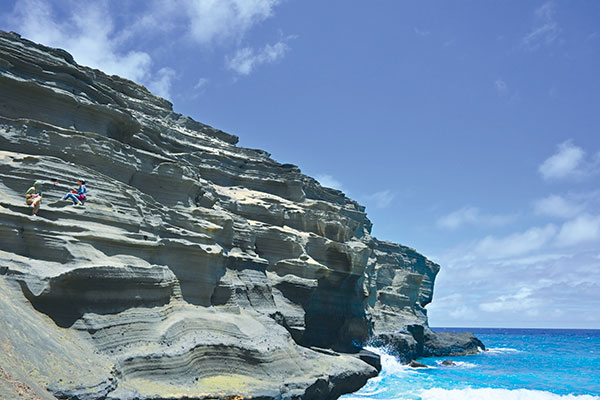
Clearing the air. Nicolaysen and Namy Barnett ’23 studied an ocean-based, lava-derived process for removing carbon dioxide from the atmosphere in Hawaii. Photos (including the photo at the top of this page) by Astrid Hylén.
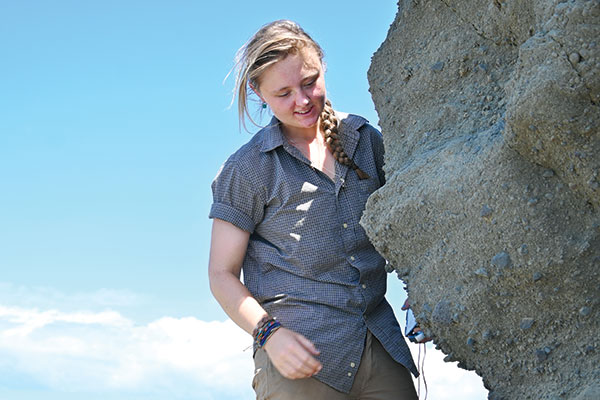
Prize-winning work. Namy Barnett ’23 won the Murdock Poster Prize for Environmental Science-Geology for her research with Professor of Geology Kirsten Nicolaysen in Hawaii. Photo by Astrid Hylén.
“Basically, Vesta is interested in adding olivine sand to beaches or other coastal systems. The waves crashing on the beach would increase the rate of the weathering of the olivine sand and reduce ocean acidity to draw down carbon dioxide,” says Barnett.
“That brought us to Hawaii, where I was looking at the dissolution features of olivine grains on a naturally occurring greensand beach and the implications they had for coastal enhanced weathering projects.”
“There’s a lot of excitement and wonder involved. When lava comes out, those rocks are just made. It’s so rare that you get to hold rocks that are one day old.
”
Namy Barnett ’23
For her research, Barnett won the Murdock Poster Prize for Environmental Science-Geology at the 2022 College Research Science Conference hosted by the M.J. Murdock Charitable Trust. She recently completed an internship with the Hawaiian Volcano Observatory, where she analyzed and characterized current eruption samples.
“There are a lot of human-impact reasons to study volcanoes, both in terms of their impact on humans and our impact on the Earth,” says Barnett. “But also, for me, there’s a lot of excitement and wonder involved. When lava comes out, those rocks are just made. It’s so rare that you get to hold rocks that are one day old.”
Finding a Green Future in a Volcanic Past
Recent graduate Wamuchii Mwangi ’24 also studied the relationship between volcanoes and environmental sustainability while at Whitman. After discussing several senior thesis topics with Nicolaysen, Mwangi decided to focus her research on rare earth elements. These elements are essential components of wind turbine magnets, some solar panels and electric vehicle batteries. These so-called “critical minerals” are concentrated in rocks that come from rare carbon-rich magmas known as carbonatites and are integral to the transition to green energy.
Mwangi studied older carbonatite magmas from the Mountain Pass Rare Earth Mine and Processing Facility, located in the Mojave Desert in southeastern California. Mountain Pass is the only rare earth mining and processing site in the United States.
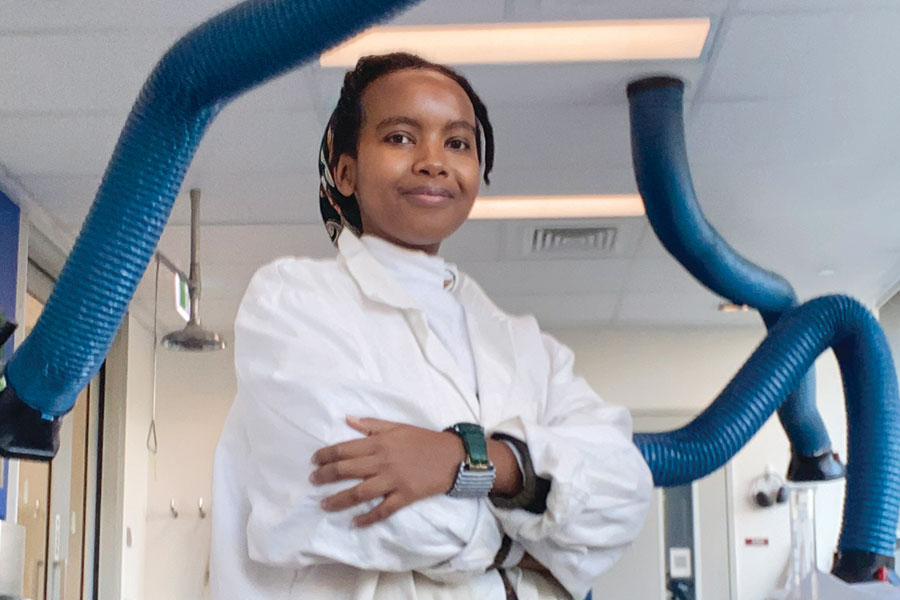
Mining the future. Wamuchii Mwangi ’24 focused her thesis research on rare earth elements that come from magma and are critical to a green energy future.
“I studied these rocks to see which rare earth elements were there and their concentration,” Mwangi says. “But it wasn’t purely academic for me. It was something that I felt was in line with my thinking about the connection between mining and justice. It was my way of participating politically in the world.”
Mwangi notes that traditional mining of fossil fuels like oil and gas has had devastating effects on both the planet and its people. She hopes that history won’t repeat itself. “Even while doing the science, I’m thinking of its intersection with society,” Mwangi says. “If we do not learn and are not aware of the mistakes we made with oil and gas, we will make the same mistakes with green energy.”
Rocking at Mentorship
By the end of 2025, Nicolaysen will have directly mentored 64 students and co-mentored several more throughout her career at Whitman. Many of them have been women and members of other groups who are underrepresented in the geosciences.
“Good mentorship should develop confidence that allows you to step into new spaces with curiosity and eagerness,” says Mwangi. “Because of the way Kirsten worked with me, I really feel empowered.”
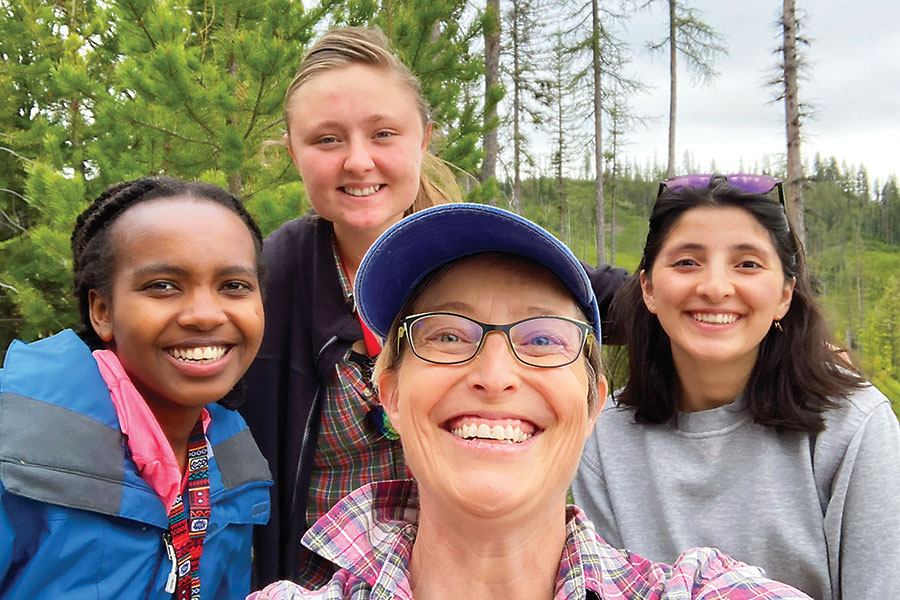
Hands-on expertise. Dozens of students, including (left to right) Wamuchii Mwangi ’24, Namy Barnett ’23, and Mehrimo Bakhtalieva ’25, have gained valuable experience through their fieldwork with Professor of Geology Kirsten Nicolaysen.
Barnett was working at a restaurant in Walla Walla when she met a Whitman alum who had majored in Geology. The alum encouraged Barnett to seek out Kirsten Nicolaysen as an advisor. When Nicolaysen later sent out an email asking if any students would be interested in helping her do some research over the summer, Barnett jumped at the chance.
“Working with Kirsten changed the entire course of my life,” Barnett says. “Truly everything that I’ve ever wanted to do is because of her, and she has opened a thousand doors for me. I could not be more grateful for her mentorship and guidance.”